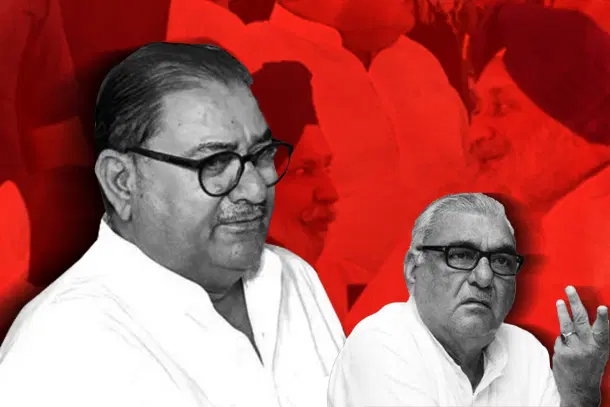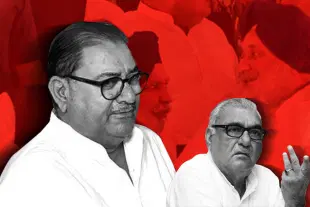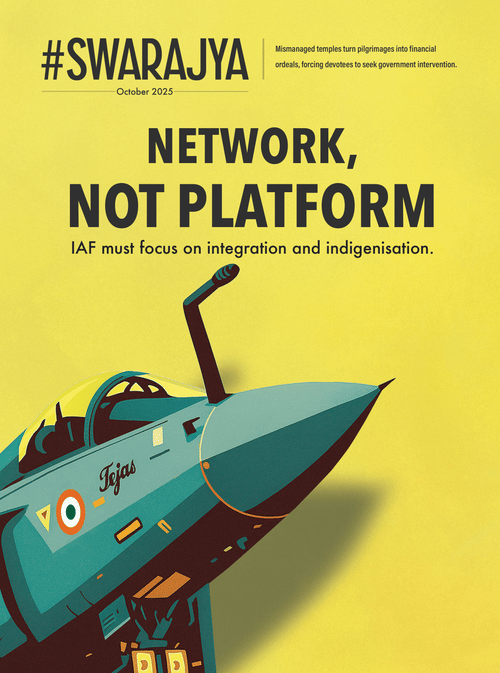Politics
Tussle Of The Jats, For The Jats: Abhay Chautala Plots Comeback Against Hooda
Abhishek Kumar
Oct 08, 2025, 01:28 PM | Updated Oct 09, 2025, 12:34 PM IST
Save & read from anywhere!
Bookmark stories for easy access on any device or the Swarajya app.


Rohtak, the unofficial headquarters of the Haryana section of Jatland, witnessed yet another round of the ongoing contest between the families of former Deputy Prime Minister Chaudhary Devi Lal and senior Congress leader Bhupinder Singh Hooda.
The renewed rivalry between Abhay Singh Chautala, grandson of Chaudhary Devi Lal, and Bhupinder Singh Hooda exemplifies the continuing struggle for Jat support at a time when the community seeks a stable political affiliation.
To refresh the reader's memory, it was exactly a year ago, 8 October 2024, that the BJP won 48 of 90 seats in the Haryana Assembly and returned to power—its third consecutive term in Haryana. The Congress secured 37 seats, when it was expected to sweep the state. The Indian National Lok Dal (INLD) won two seats, and independents took three.
This was a shock result for Bhupinder Singh Hooda. Even till the morning of results day in 2024, Hooda was expected to lead Congress back into power and the Jat community back to a position of pre-eminence.
Over the previous 10 years, the BJP government was perceived as organised around the principle of 'non-Jat politics'. Both its chief ministers, Manohar Lal Khattar and Nayab Singh Saini, belonged to communities other than the Jat.
With the Congress' third consecutive loss, it was only a matter of time that Hooda's position as the 'no.1' leader of the Jat community in Haryana also came under threat.
The latest and the strongest challenge has come from Abhay Singh Chautala of the INLD.
The Indian National Lok Dal (INLD) was founded in 1996 by Chaudhary Devi Lal as the Haryana Lok Dal (Rashtriya). It became a major party in Haryana advocating farmers’ rights and rural interests. After Devi Lal, it was led by Devi Lal’s heirs, including Om Prakash Chautala and Abhay Singh Chautala.
The INLD governed Haryana under Om Prakash Chautala from 1999 to 2005, including winning a big majority in 2000 (47 of 90 seats). It however crashed to nine seats in 2005 before somewhat reviving to 31 seats in 2009.
Thereafter, it went from marginalised to irrelevant in Haryana politics with tallies of 19, one and two across the 2014, 2019, and 2024 Assembly election respectively.
However, its leader senses an opportunity now.
Chautala vs Hooda
Abhay Singh Chautala, the President of the Indian National Lok Dal (INLD), has accused Hooda of compromising the interests of the Indian National Congress (INC) for personal gain.
On 29 September 2025, Chautala said that Hooda does not want any Haryana INC leader to emerge as a contender against his son Deepender Singh Hooda. He alleged this is why leaders such as Rao Inderjit, Birender Singh, Kuldeep Bishnoi, and Kiran Choudhary were sidelined.
In a sustained critique over the past months, he has claimed that Hooda acted in concert with the BJP by nominating 16 underwhelming candidates to secure protection from alleged corruption charges. He doubled down on this charge ahead of a massive rally organised in Rohtak, on the 112th birth anniversary of his grandfather.
After Rao Narendra Singh, a non-Jat leader, was appointed State INC President on Hooda’s recommendation, INLD revived old charges of cash-for-change in land use (CLU) against Rao Narendra Singh. The CD in which Singh discussed a multi-crore deal for CLU was first released by Abhay Singh Chautala in 2013.
Targeting Hooda in Rohtak provides Chautala the opportunity to present himself as a contender to fill the vacuum in Jat politics.
His grandfather, Chaudhary Devi Lal, whose appeal extended across northern India, is regarded as one of the most prominent figures from the Jat community. In 1989, he secured victory in the Rohtak Lok Sabha seat, previously consolidated by Bhupinder’s father, Ranbir Singh Hooda in the 1950s.
Chaudhary Devi Lal later resigned from this seat in favour of the Sikar constituency in Rajasthan, after which he could not return as an MP.
Bhupinder Singh Hooda defeated him three times in Rohtak, consolidating Jats under his influence.
Politics of Jatland
With the rise of the Hoodas, INLD began to decline, while the BJP experienced a resurgence after the 2014 assembly elections. The INLD’s poor performance and internal disenfranchisement, combined with the BJP’s 'Jat-versus-others' strategy and Hooda’s manoeuvring, deepened divisions within the party, eventually leading to the formation of the Jannayak Janta Party (JJP) in 2018.
Under Dushyant Chautala, nephew of Abhay Singh Chautala, the JJP won ten seats on an anti-BJP campaign in the 2019 Assembly Elections. Despite this platform, the JJP became a coalition partner in the BJP government in 2019, with Dushyant appointed as Deputy Chief Minister.
In the 2024 Assembly Elections, the JJP’s performance plummeted from 10 to zero seats, with none of its candidates able to retain their deposits. At that time, the JJP’s decline allowed Hooda to claim near-unilateral control over Jat voters across the state.
However, post-election, Hooda’s supremacy has given way to complacency.
The perception of him as a compromised leader is gaining traction, weakening his image further. Additionally, the Hooda family has allegedly become inaccessible in recent years, with very few leaders able to communicate with them. This is a significant reason why some INC leaders have joined INLD in recent months.
Hooda's son, Deepender Singh Hooda, though a successful parliamentarian, is unlikely to emerge as the Jats’ primary representative, as he lacks the agitative style often associated with their leaders.
“When it comes to politics, they gravitate towards leaders who embody decisiveness and assertiveness rather than quiet diplomacy. This temperament naturally aligns them with street-level mobilisation and confrontational, agitational politics, where pride, visibility, and symbolic assertion often matter as much as policy or ideology,” said Arunoday Gupta, a consultant.
Abhay Singh Chautala understands this fully, explaining his extensive travels over the past year, especially following the death of his father, Om Prakash Chautala. The principle of uncompromising honour was evident even during O. P. Chautala’s lifetime, when Ajay Singh Chautala, as JJP chief, offered to rejoin INLD but was rebuked as a ‘traitor’ by Abhay.
“Earlier, too, Chautala sahab made it clear many times that they have nothing to do with us. They are traitors and they backstabbed the party. They betrayed Chautala sahab," said Abhay.
INLD attempts to revive
Earlier this year, the party decided to implement an organisational overhaul, setting 25 April as the deadline for restructuring units in eight districts: Gurugram, Faridabad, Rewari, Palwal, Mewat, Rohtak, Jhajjar, and Sonipat. Abhay Singh Chautala specifically instructed district officials to include only those who adhere to the clean politics championed by Chaudhary Devi Lal.
Chautala also advocated for the return of old party workers. This was a key motive behind his decision to visit all 90 assembly constituencies in the state. Throughout his yatra, Chautala and his team prioritised workers over fence-sitters, gaining momentum with the slogan ‘One booth, ten Youth’.
By the end of July 2025, Chautala announced that the party had achieved 90 per cent of its target, enrolling nearly five lakh new members across Haryana and forming over a dozen new cells.
These developments set the stage for the grand rally on Chaudhary Devi Lal’s birth anniversary in September. Although the ‘Samman rally’ is an annual event, the vacant space of O. P. Chautala and recent organisational activities added new dimensions. With only two MLAs from the family, the rally aimed to attract old workers and potential defectors from other parties.
On 25 September 2025, Abhay Chautala was ceremonially adorned with a 331-metre-long turban, prepared by Khaps. He vowed to remove both BJP and INC from Haryana’s political map and promised free electricity, jobs, and the elimination of corruption.
Attacking the Hoodas in their bastion, Chautala said, “In 2019, the people had made up their mind to throw BJP out of power, but the Jannayak Janta Party, winning ten MLAs in the name of Chaudhary Devi Lal, betrayed the people of the State and helped the BJP form the government. The JJP was wiped out this time. But the father-son duo helped BJP form its government for the third time.”
The rally saw higher than usual attendance, and local media reported significant online participation.
For other political parties, the rally was notable for its high-profile attendees, including Shiromani Akali Dal president Sukhbir Singh Badal, former Lok Sabha MP K. Kavitha, Jammu and Kashmir Deputy CM Surinder Choudhary, and former Haryana finance minister Professor Sampat Singh, who shared the dais.
Sampat Singh was the most controversial attendee before the rally, amid rumours of re-defection from INC to INLD. Singh, a devotee of Devi Lal, has a history of switching sides. The rally, projected as a revival of Devi Lal’s legacy, was seen as an official announcement of Sampat Singh's homecoming.
During his speech, Singh appealed to the audience to strengthen Chautala to promote Devi Lal’s ideology. While he later denied joining INLD, he criticised the Congress' decisions, including the appointment of Rao Narendra Singh as president of the state INC unit.
Anatomy of Jat votes and problems for INLD
Even though INLD is known for organising successful rallies, the 2025 version brought renewed organisational energy and a nostalgic appeal to reconnect with a Jat and farmer identity. However, considering Haryana’s growth over the past 30 years, INLD may need to adjust its strategy.
Jat voters are the primary target of INLD, but the Jat voters of the pre-1990s differ from those in the third decade of the 21st century.
Large parts of western and southern Haryana are now driven by real estate, logistics, and service-sector aspirations. Decades of urbanisation, upward financial mobility, social change, and intra-Jat political divisions have produced younger Jats who prioritise strengthening their own households before political engagement.
Far from the traditional agrarian image, an increasing number of Jats today are salaried professionals, entrepreneurs, real estate brokers, IT employees, and consultants.
Identity consciousness is a major factor. Self-gained leverage, minimal state interference, and a strong work ethic have reinforced a larger Hindu identity.
This explains why, even if BJP appears following non-Jat politics, its larger appeal in uniting communities under the Hindu umbrella resonates with younger Jats. Nationalism is another factor, as seen in the 2019 general elections.
Their unease with BJP emerges more during state assembly elections. Taking on the BJP during state elections demonstrates Jat confidence in their political influence. They have internalised the power of mobilisation, often acting independently.
As one consultant noted, “Once a community learns the power of getting its job done while in opposition, it is the party that needs the community, not the other way around. Jats have learnt to get their demands fulfilled from anyone.”
This poses a challenge for Abhay Singh Chautala. The political struggle of the last three-and-a-half decades, combined with economic advancement, has made the Jat community a mobile political class. They retain the power to shift allegiances when necessary. To secure loyal support, any political party must instil confidence that it will never compromise the community’s interests.
BJP has demonstrated how non-Jat politics can succeed in Haryana by forming coalitions with other communities. Consolidating only Jats may not yield the desired results for INLD or any other party.
INLD faces the complex task of securing Jat support while also bringing other communities on board.
Abhishek is Staff Writer at Swarajya.





